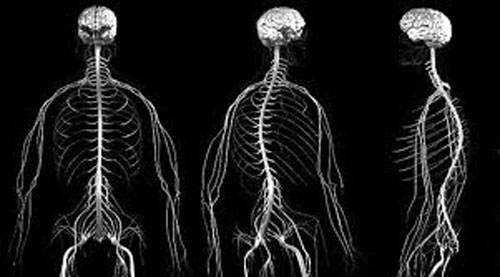Understanding the Vagus Nerve: Interview with Dr. Stephen Porges

Yogis know that practice positively affects physical health – but what’s the deal with the vagus nerve? Renowned neuroscientist Dr. Stephen Porges explains.
It might seem obvious, but our nervous system is affected by everything we do. In the trauma-filled wake of recent gun violence in schools and the overwhelmingly heartbreaking stories shared during the #MeToo movement, conversations around wellness, trauma, and mental health have been thrust into the mainstream. Now more than ever, people are questioning what it means to be safe and what happens when we are threatened, on edge, and stressed.
Dr. Stephen Porges is an expert on understanding how these situations wreak havoc on our physiology – and also the champion of hope in identifying tools to restore homeostasis and bring nervous system back into its optimal state of harmony. His revolutionary research begat the Polyvagal Theory, an idea, he says, that “really presented a different worldview. It changed how people perceive the autonomic nervous system”.
Our understanding of the nervous system hadn’t evolved much over the past 100 years, but Porges’ work regarding the vagus nerve flipped the discipline on its head. If you’ve taken a basic neuroscience or mind-body connection class in the last 10 years, you’ve likely came across this work – but you also experience it when practicing meditation, PRANAYAMA, and HATHA YOGA.
Why was this work so revolutionary? Porges’ Polyvagal Theory was the first to apply evolution as an organizing principle to identify and understand the brain structures that regulate and are regulated by our bodily organs. The theory provides the neuroscience foundation for mind-body practices and a mind-body science.
What is the vagus nerve?
To give you some color, the vagus is the tenth and longest cranial nerve. It runs from the brain to the lower abdomen and interfaces with the heart, lungs, and digestive tract. The Polyvagal Theory recognizes the relationship between the vagus’ parasympathetic control of these bodily systems and life’s visceral experiences. Because of this unique connection between our lived experiences and our physiological responses, vagal tone in humans has become an important index for mental and physical health.
For one, the vagus nerve helps regulate the immune system. It has also been shown to reduce inflammation, boost oxytocin (read: increased love and connectedness!), and even play a role in determining stem cell growth rate. In other words, this nerve has its pulse on almost everything we do. But, the reverse is also just as true. Everything we think and do affects our body and brain through the vagus nerve.

Defining the Polyvagal Theory
Essentially, the Polyvagal Theory describes our nervous system’s response to stress or danger in three hierarchical systems:
1. A “safe” zone: We feel good about ourselves because we don’t feel under any immediate threat. These feelings of safety are supported by the ventral vagal complex, an area in the brainstem regulating the heart and the striated muscles of the face and head.
2. Fight-or-flight: We may experience an activation when stressors arise in our life or environment, like boarding a plane when you’re afraid of flying, or hearing an unexpected noise in your home in the middle of the night. These feeling of defense are supported by the sympathetic nervous system.
3. Complete immobilization: What Dr. Porges likens to total “shutting down” mediated by an evolutionarily ancient motor pathway in the vagus that originates in the brainstem nucleus known as the dorsal nucleus of the vagus. When we completely freeze, as is the case with some who experience severely acute or chronic stressful situations (such as sexual assault and rape), our physiology signals to reduce metabolic output as we experience such danger. When we feel “numb” or “frozen” – as many with PTSD (post traumatic stress disorder) do – our dorsal vagal system is in the driver’s seat and we respond like a mouse in the jaws of a cat.
So, what exactly qualifies as a stressor that triggers this cascade of changes in the brain and body?
Autoimmune Disease and the Nervous System
The sad truth is that lot of what we do is out of alignment with what’s best for our nervous system. We do silly things like skip meals, or scarf down food and run out the door with little consideration for digestion and how that affects everything from our memory to energy level. According to Dr. Porges, rising autoimmunity and other bodily disorders – like fibromyalgia and dysautonomia – might be best categorized as “the nervous system in a state of defense”.
By keeping our nervous system out of chronic defense, it’s likely that we will experience better health. The nervous system is largely connected to the gut, so it makes sense that the rise in “invisible illnesses” is connected to the vagus and the body’s ability (or lack thereof) to regulate taxing attacks that biologically speaking shut us down. The beauty of the Polyvagal Theory is that it creates a framework that allows us to better understand how to regulate and care for our nervous systems in a world that’s progressing at the speed of light with a human biology that is not designed for the enormous demands we place upon ourselves.
Learning How to Listen to the Body
Talking to Dr. Porges revealed how apparent it is that our world hasn’t always valued the process of learning to understand what our body is trying to tell us. Many of us were never taught how to return to a safe state when feeling stressed or out-of-balance. Where should one start?
“I would tell them that the world that we’re in is very demanding,” says Dr. Porges, “and it’s demanding not only on our psychological and emotional processes, but it’s also demanding on our body. We can meet these demands, but we also must schedule time to allow our body and our mental communication with our body to be safe and relaxed. We need recovery times, and with these recovery times, we’ll start building resilience. By moving in and out of a state of safety to respond to demands and to recover from demands is what our nervous system evolved to efficiently accomplish.”
Dr. Porges’ work has shaped his spiritual and daily practices, as well as how he lives and interacts with others. Growing up, Dr. Porges was an avid track athlete and clarinetist – in fact, he pursued both at the collegiate level. These interests became the foundation of this groundbreaking theory that helped him discover his desire to do-away with “dustbowl empiricism”, and ignited his passion to further our understanding of the mind-body connection.
“Purpose is everything. It’s our engine that keeps us alive”, he says. But “becoming a parent taught me that I was making a blunder. As a parent, I didn’t initially have the insight that being soothing and calming had the ability to make reactive behaviors disappear. It became clear to me that state-dependent behaviors can be changed with compassion and slowing things up”, he says. Everything, from acted-out social behaviors to internal feelings, connect to and deeply affect our autonomic nervous system-as well as those around us.
Resetting the Nervous System
If you’re feeling out of touch with your body and ready to work with your nervous system instead of against it, Dr. Porges had these suggestions:
Extend the Duration of Your Exhale

Conscious breathing regulates what the vagus nerve is telling your bodily organs. When feeling stressed or overwhelmed, use breath as an anchor and focus on it. Slowing down exhalation promotes the dominance of the parasympathetic system, which can help you bring your body back to a calm state of safety. When we extend exhalation, the increased vagal influence slows our heart, rate, which has a calming effect. When stressed or feeling an oncoming pang of panic, our typical response is to take short, shallow breaths, which by withdrawing the vagal influence on the heart increases heart rate and leaves you feeling less grounded and more aroused.
Practices like PRANAYAMA produce vagotropic effects that slow breathing and pulse rate while improving the blood-flow to the heart. Eliciting the relaxation response through mind-body practices, like transcendental meditation and prayer, are excellent ways to decrease carbon dioxide elimination and slow your body down: extending your exhale for 2-4 seconds longer than usual is enough to notice an effect. Release your breath to let the anxiety and tension in your body go.
Sing and Listen to Music with Other People
A central tenet of the Polyvagal Theory is feeling connected, because we are firmly grounded in our relaxed state thanks to the a specific (i.e., ventral) vagal pathway that originates in an area of the brainstem that regulates the striated muscles of the face and head that are involved in listening, vocalizing, and facial expression. According to Dr. Porges, this system enables us and other mammals to be social. “Singing and listening to music are other portals to change state,” says Dr. Porges. If you’ve ever jammed to a favorite song while driving on an open road, you know how quickly music and singing can shift your mood. In fact, Tibetan lamas maintain elevated carbon dioxide levels when extending the exhalation during chanting. Being social plays a large role in providing the safety our nervous system needs to shift out of defensiveness.
Porges coined the term “neuroception” to describe how our neural circuits, without conscious awareness, distinguish situations and people of safety and danger. Neuroception of safety is required before social engagement behaviors occur for social bonds to develop. “Neuroception is a bodily and not a cognitive awareness of the cues that trigger our physiology into a different stage” says Dr. Porges, “which occurs at a level below our consciousness.” Neuroception explains why a baby coos at his or her mother’s voice and cries at a stranger’s.
“We need a certain amount of social interaction,” he says. “We live in a digital, asynchronous world, but our nervous system is screaming for social interaction.” Put down the phone and get outside to enjoy face time in real time. When we are at peace and relaxed (think: enacting the ventral vagal pathway), we are calm, open to connecting with others, and adaptable.
Stand Up and Bring Awareness to Your Posture
“Standing up shifts our alertness and triggers changes in blood pressure,” says Dr. Porges. In many yoga and meditation classes, you might wonder why there is an emphasis on body alignment and posture. “Grounding” is a common term in mind-body practices that refers to allowing a full exhalation and relaxing of the diaphragm. If you sit for long periods of the day, especially in front of a computer screen, or commuting in a car, it might be time to take a serious look at the way you’re sitting.
Simply adjusting your posture can shift your awareness and energy. By maintaining good posture during extended exhalation (which is the body’s way of relaxing), you activate the parasympathetic nervous system. While you might think it’s oh so easy to just let gravity do its thing, maintaining isometric posture holds require consistent practice that will strengthen your core and allow you to relax during any activity.
Really Listen to Your Body
You might be curious what the Polyvagal Theory’s own creator does every day to promote a healthy-vagal tone. In fact, his answer was really simple:
“What I do is: I’m functionally mindful of my bodily state, so I become very aware of shifts in my body and I try to respect those shifts and try to functionally move my body into situations in which it will feel safer. There are times, inevitably, you feel disrupted, and if you have enough control over your environment, you basically say: ‘Body, I’m going to move to a quiet place’. But when you’re in certain work environments, you really don’t have that luxury. What I do now is I kind of evaluate what my body can handle, and if things become overwhelming, I’ll make sure I have a break, some quiet time where I’m in a quiet place.”
Protecting our body is key to vagal tone recovery and restoration. In our go-go-go culture infatuated with instant gratification and the glorification of being busy, ensuring continuity of body and mind is vital to health. Now more than ever, it’s palpable that the prescription for a life-well lived lies is in finding balance among life’s many competing priorities and becoming mindful of your body and physiological state changes that have a greater effect on you (and others!) than we’ve always thought.

Communities and immersive experiences create a sense of safety that allow for authentic, restorative social connection. “When we allow our bodies to be safe, all forms of communication become available to us,” says Dr. Porges. Increased vagal tone combats stress and increases relaxation, which means that fine-tuning your self-care with the vagus nerve, perhaps by using the above suggestions, is something you should be incorporating into your daily life.
Currently, Dr. Porges’ Polyvagal Theory is taking on new life in many other disciplines including education, veterinary medicine, palliative care, and more. It’s being used to uncover how faulty neuroception may be at the root of psychiatric disorders and the role social engagement plays in a well-rounded education.
When delving into the body-spirit connection, Dr. Porges cautions against giving into trends that haven’t been vetted by time or experts. Biohacking, he says, may be one of them. Rather than honing in specific trends, it’s important, he says, to take a more integrated view of how our nervous system and our body work. “We then try to create situations where it becomes self-organizing and where it becomes resilient,” he says, rather than “just tweaking certain functions like performance. You can push these systems, but is there a price to pay.”
He leaves with a laugh: “And that’s for the next generation to figure out!”
yogaesoteric
January 27, 2019
